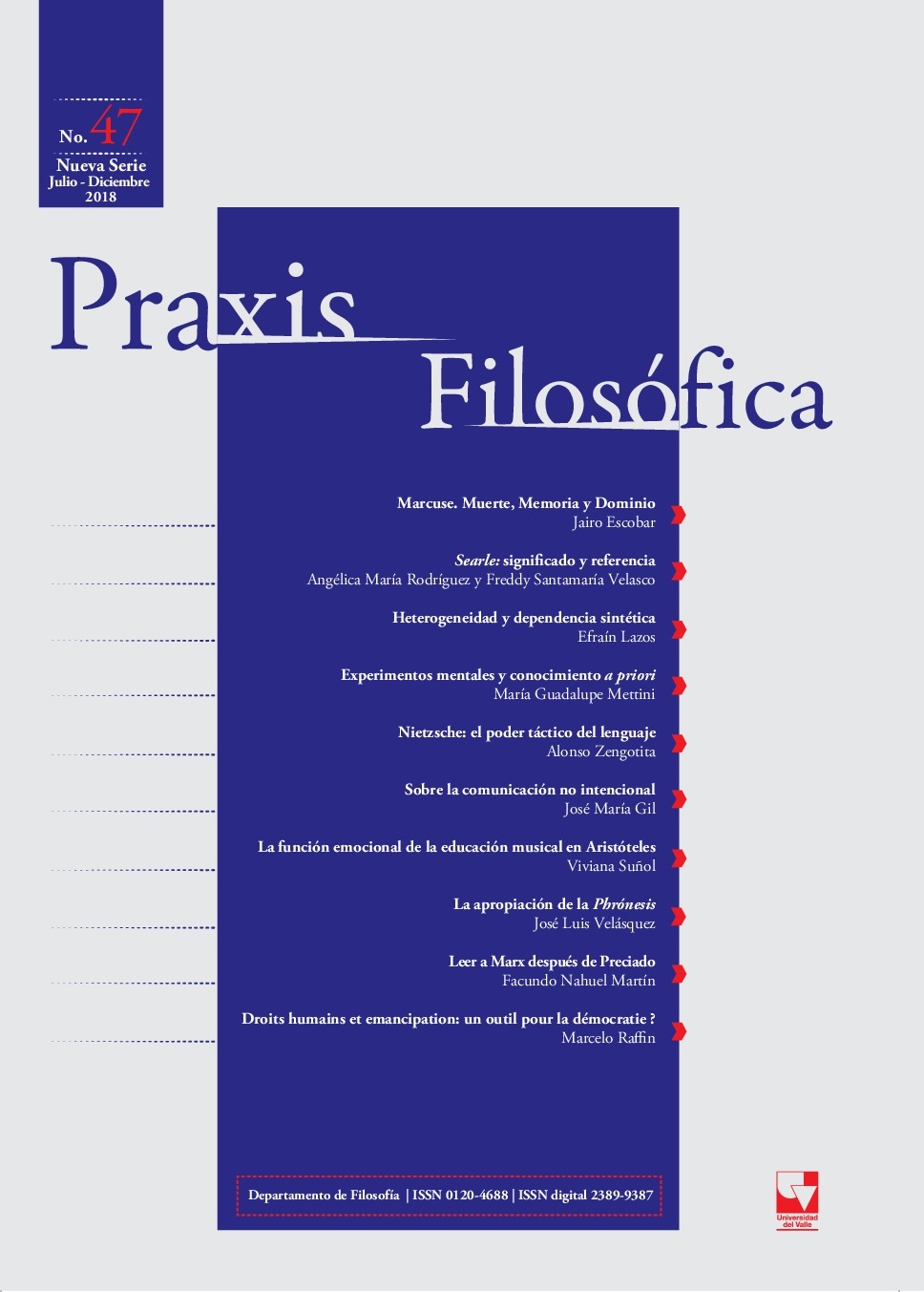Sobre la comunicación no intencional
Contenido principal del artículo
En filosofía del lenguaje, el estudio de la comunicación y los procesos cognitivos le ha correspondido tradicionalmente a la pragmática. Dentro de este campo, uno de los objetivos fundamentales es caracterizar los procedimientos involucrados en la transmisión y el reconocimiento del significado intencional. En efecto, la pragmática puede explicar la comunicación en términos de dicho significado intencional. Sin embargo, hay también un fenómeno muy común en el uso cotidiano del lenguaje: Muchas veces, con muy buenas razones, el oyente interpreta que el enunciado del hablante evoca ciertos significados que poco o nada tienen que ver con la intención. A este fenómeno tan cotidiano lo podemos llamar comunicación no intencional. El análisis filosófico permite pues explicar que, por ejemplo, un acto fallido es un hecho comunicativo en el cual los significados que interpreta el oyente a partir del enunciado son muy diferentes de (y hasta incompatibles con) el significado intencional del hablante.
- comunicación
- procesos cognitivos
- significado intencional
- significado no intencional
- redes relacionales
Atlas, J. (2005). Logic, Meaning, and Conversation: Semantical Underdeterminacy, Implicature, and Their Interface. Oxford: Oxford University Press.
Austin, J. L. (1988). Cómo hacer cosas con palabras. Barcelona: Paidós. (Trabajo original publicado en 1962).
Bach, K. (2006). The top 10 misconceptions about implicature. En B. Birner & G. Ward (Eds.), Drawing the boundaries of meaning: Neo-Gricean studies in pragmatics and semantics in honor of Laurence R. Horn (pp. 21-30). Amsterdam: John Benjamins.
Blutner, R. y Zeevat, H. (2003). Optimality Theory and Pragmatics. Londres: Palgrave.
Carston, R. (2004). Relevance theory and the saying/implicating distinction. En L. R. Horn & G. Ward (Eds.), The handbook of pragmatics (pp. 633-656). Oxford: Blackwell.
Chomsky, N. (2005). Three Factors in Language Design. Linguistic Inquiry, 36(1), 1-22.
Chomsky, N. (2000). On nature and language. Nueva York/Cambridge: University Press.
Dascal, M. (1999a). Presentación. En M. Dascal (Ed.), Filosofía del Lenguaje II: Pragmática (pp. 11-20). Madrid: Trotta.
Dascal, M. (1999b). La pragmática y las intenciones comunicativas. En M. Dascal (Ed.), Filosofía del Lenguaje II: Pragmática (pp. 21-51). Madrid: Trotta.
Gil, J. M. (2013). A Neurocognitive Interpretation of Systemic-Functional Choice. En L. Fontaine, T. Bartlett & G. O’Grady (Eds.), Choice: critical considerations in Systemic Functional Linguistics (pp. 179-204). Cambridge: Cambridge University Press.
Gil, J. M. (2014). Significados no intencionales en la comunicación. Lenguaje, 42(1), 43-66.
Gil, J. M. (2015). Significados no intencionales: de la exclusión a la inclusión. Dianoia, LX(74), 53-80.
Grice, H. P. (1957). Meaning. Philosophical Review, 66, 377-388.
Grice, H. P. (1968). Utterer’s meaning, sentence meaning and word meaning. Foundations of Language, 4, 225-242.
Grice, H. P. (1981). Presupposition and conversational implicature. En P. Cole (Ed.), Radical pragmatics (pp.183-198). Nueva York: Academic Press.
Grice, H. P. (1982). Meaning revisited. En N. V. Smith (Ed.), Mutual Knowledge (pp. 223-243). London: Academic Press.
Grice, H. P. (1989). Studies in the Way of Words. Cambridge: Harvard University Press.
Grice, H. P. (2002). Logic and conversation. En D. J. Levitin (Ed.), Foundations of cognitive psychology: Core readings (pp. 719-732). Cambridge: MIT Press. (Obra original publicada el 1967).
Hjelmslev, L. (1943). Prolegomena to a theory of language. Madison: University of Wisconsin Press.
Horn, L. (2004). Implicature. En L. Horn & Gregory Ward (Eds.), The Handbook of Pragmatics (pp. 3-28). Oxford: Blackwell.
Horn, L. (2005). The Border wars: A neo-Gricean perspective. En K. Turner & K. V. Heusinger (Eds.), Where Semantics Meets Pragmatics (pp. 21-48). Amsterdam: Elsevier.
Horn, L. (2007). Neo-Gricean pragmatics: A manichaean manifesto. En N. Burton-Roberts (Ed.), Pragmatics (pp. 158-183). Londres: Palgrave.
Kadmon, N. (2001). Formal Pragmatics: Semantics, Pragmatics, Presupposition and Focus. Oxford: Blackwell.
Lamb, S. M. (1999). Pathways of the Brain: The Neurocognitive Basis of Language. Amsterdam: John Benjamins.
Lamb, S. M. (2004). Language and Reality. Londres: Continuum.
Lamb, S. M. (2005). Language and Brain: When experiments are unfeasible, you have to think harder. Linguistics and the Human Sciences, 1, 151-178.
Lamb, S. M. (2013). Systemic networks, relational networks, and choice. En L. Fontaine, T. Bartlett & G. O'Grady (Eds.), Choice: critical considerations in Systemic Functional Linguistics (pp.137-160). Cambridge: Cambridge University Press.
Lamb, S. M. (2016). Linguistic structure: A plausible theory. Language under Discussion, 4(1), 1-37.
Levinson, S. (2000). Presumptive Meanings: The Theory of Generalized Conversational Implicature. Cambridge: MIT Press.
Levinson, S. (2006a). Cognition at the heart of human interaction. Discourse Studies, 8, 85-93.
Levinson, S. (2006b). On the human ‘interaction engine. En N. Enfield & S. Levinson (Eds.), Roots of Human Sociality. Culture, Cognition and Interaction (pp. 39-69). Oxford: Berg.
Searle, J. (1969). Speech Acts: An Essay in the Philosophy of Language. Cambridge: Cambridge University Press.
Searle, J. (1975). A Classification of Illocutionary Acts. Language in Society, 5(1), 1-23.
Searle, J. (1977). Actos de habla indirectos. Teorema, VII(1), 23-53.
Sperber, D., & Wilson, D. (1995). Relevance. Communication and Cognition. Oxford: Blackwell.
Sperber, D., & Wilson, D. (2005). Pragmatics. UCL Working Papers in Linguistics, 17, 353-388.
Stalnaker, R. (1999). Context and Content: Essays on Intentionality in Speech and Thought. Oxford: Oxford University Press.
Strawson, P. (1950). Sobre el referir. En L. M. Valdés Villanueva (Comp.), La búsqueda del significado (pp. 60-84). Madrid: Tecnos.
Wittgenstein, L. (1988). Investigaciones filosóficas. (A. Suárez & U. Moulines, Trad.). México: UNAM. (Trabajo original publicado 1953).
Descargas
Aceptado 2018-06-18
Publicado 2018-07-15

Esta obra está bajo una licencia internacional Creative Commons Atribución-NoComercial-SinDerivadas 4.0.
De acuerdo con nuestra política (Licencia Creative Commons CC BY-NC-SA 4.0) los artículos presentados y sometidos al proceso editorial en la revista Praxis Filosófica no tienen costo alguno para sus autores ni retribuciones económicas para la revista. El artículo de carácter inédito, producto de investigación o de algún proyecto que se presente a Praxis Filosófica, no podrá estar sometido a otro proceso de publicación durante el proceso que se lleve en nuestra revista.





